Since it looks like the rain has left us for the summer (hope not, but the long-range predictions aren’t good), I’m posting flower pictures while we have some–and we have some.
An increaser in the west grass, mentioned before, is the Illinois Basketflower, Centaurea americana. this tallish forb’s buds look a lot like thistles:
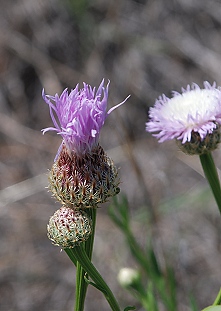
It’s not a thistle, though. The flowers attract butterflies, bumblebees and other bees, various flies, and are large and beautiful:
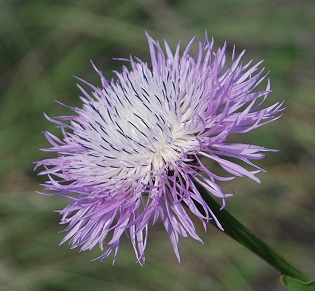
Like many of the native plants, they move around from year to year, giving us a surprise. We used to have a lot in the “entrance meadow” of the creek woods, but this year we have only a few small ones. Something else new this year, that I’ve noticed only in this part of the west grass, is association of carrot-family plants with the basketflowers:
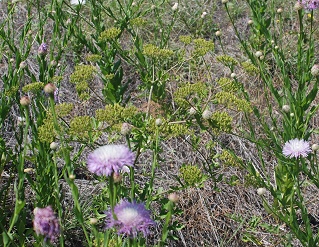
The yellow-green flowerheads of Prairie Parsley, Polytaenia nuttallii, are interspersed with the basketflowers in this patch, and in an adjoining patch it’s mostly Queen Anne’s Lace. Since some of the swallowtails lay their eggs on the carrot-family plants, and nectar on basketflower, this is a handy association.
The various coneflower-group of wildflowers are peaking now; the commonest is the Prairie Coneflower, Ratibita columnifera.
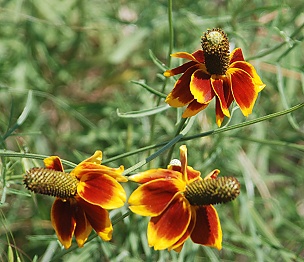
It forms a rather messy mound; the proportions of yellow to red, and the depth of the red (can be mahogany brown) vary from clump to clump. Most of our plants have a double-frill of ray flowers.
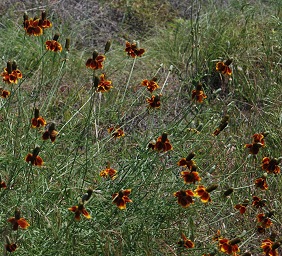
Less common, and forming a neater clump with fewer individual flowers (usually) is the yellow coneflower, another Ratibita, possibly tagetes.
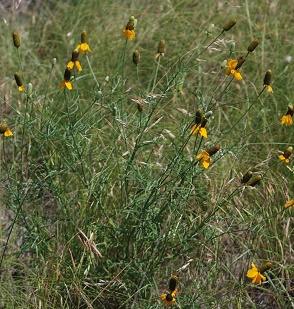
Individually, the flowers are a brilliant pure yellow.
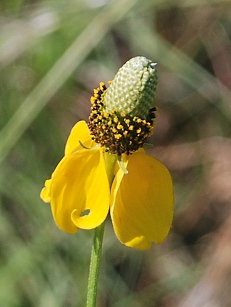
All the yellow coneflowers have a single row of ray flowers; I enjoy the differences between the two related species.
Comment by Marjorie Procter-Smith — June 5, 2009 @ 10:41 am
Great photos. We don’t have as many coneflower varieties; just clasping-leaf, mainly. But a few basketflowers came up this year (more than last year–yay!), and, to my delight, on a walk through our woods yesterday I found Illinois bundleflower. At least, I *think* that’s what it is, although it might also be yellow-puff. Either way, it’s something we have not had before. Also, Engleman’s daisy has appeared for the first time this year. Not bad for what is essentially a drought year.
Comment by elizabeth — June 5, 2009 @ 11:16 am
I have been amazed every year as one thing after another has reappeared. We have a big Mirabilis (not sure if it’s albida or gigantea) that showed up in year seven, I think it was, as a waist-high plant, and now it’s in several other places as well. The most gorgeous deep magenta flowers in late afternoon in late summer, that drop off leaving the papery translucent calyx. Engelman’s daisy showed up for the first time last year (I think it was) and there’s more of it this year. We have a few specimens of pitcher sage, one of which waited five or six years before suddenly appearing four feet tall and covered with blue flowers, quite a ways from where we saw the first one.
We’ve had the bundleflower, but I haven’t noticed it yet this year (but then, haven’t had time to get to the places where it was in the past.)
Comment by Marjorie Procter-Smith — June 5, 2009 @ 5:58 pm
(furiously looking up Mirabilis and pitcher sage in Ajilvsgi; no joy).
Um, recommend a good wildflower book to supplement Ajilvsgi?
Comment by elizabeth — June 5, 2009 @ 6:18 pm
Peterson Field Guide Series has A Field Guide to Southwestern and Texas Wildflowers which is good for many things but not (alas) Pitcher Sage or Mirabilis albida. I also use the same series’ Field Guide to Wildflowers (mostly eastern but does include some in our area.) Once again, the best Pitcher Sage pictures are in at least two of the Wasowski books.
Oh–have you discovered the Wildflower Research Center’s plant guides? Here’s
the gateway page:
http://www.wildflower.org/plants/
Pitcher Sage:
http://www.wildflower.org/plants/result.php?id_plant=SAAZG
And here’s the Mirabilis albida:
http://www.wildflower.org/plants/result.php?id_plant=MIAL4
It helps if you have a clue what genus you’re looking for, or have a common name already, but they have lots of photographs of many, many plants.
Comment by Marjorie Procter-Smith — June 5, 2009 @ 7:14 pm
Excellent! Thanks. I’ll *definitely* get the Wasowski books now. Web sites are great but we have a dial-up connection that makes loading lots of pictures a big pain. I have used the Johnson Wildlife Center data base at times, but, as you say, you need a clue of some kind to know where to start, especially with a slow connection. It’s not practical for me to scan through images.
Wow. Those are gorgeous flowers. And it’s clear why mirabilis is called mirabilis. Extraordinary, indeed. But albida must have a root in albus, white, right? That purple….
Comment by elizabeth — June 5, 2009 @ 10:04 pm
I think it’s albida because the dry papery bits that stay on after the flowers fall off in the night look almost white in the light. Or maybe it’s something else–I don’t know. But what I recognize the plant by, at a distance, is the glow of those translucent, pale bracts. Then it’s almost literally a ‘four o’ clock’ plant, in that the gorgeous purply flowers only show up in late afternoon.
I do understand dial-up connections…had one for years, and finally this spring got broadband. Where we are there was only one possibility, too.
Comment by ForestWander Nature Photography — June 11, 2009 @ 9:07 am
Wonderful wildflowers.
We have those here in WV too!
Comment by elizabeth — June 11, 2009 @ 10:20 am
What I remember most vividly of my time in WV were the huckleberries and wild strawberries…and the rhododendrons, too, of course. But the berries…on plants that weren’t thorny/prickly and you could pick them without risking your fingers…were wonderful. I’d done some hiking near a WV state park (no longer remember the name, sorry) several times, but when Richard was called to duty with the Pennsylvania National Guard after his return from ‘Nam, and I had just left active duty–and given up our apartment in Alexandria, VA–I spend the next few weeks exploring bits of WV I’d read about. Wow. Oh, and I remember the orchids at a “southernmost northern bog” reasonably near Greenbriar (which is where I left from to fetch him from the National Guard camp across the line in Virginia.)
But those strawberries–OMG.